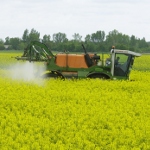Consumer safety and plant protection product residues

Even if plant protection products are used in accordance with the regulations, residues can still remain in the harvested crops.
Plant protection product residues are defined as the residues of active substances and their degradation products that remain on or in food or feed. Degradation products can occur during plant metabolism or, for example, as a result of heat, moisture or sunlight. Plant protection products are used at different times during the vegetation period or during storage. Their active substances degrade at different rates. In particular, residues are to be expected if these products are used shortly before or even after harvesting, or if the residues are especially long-lived. Maximum levels are stipulated for residues of plant protection products in food.
Before plant protection products are authorised, the residues to be expected in raw and processed foods are determined depending on the planned application conditions by means of experiments. As soon as a plant protection product is authorised, the monitoring authorities of the federal states additionally document information on actually occurring residues in foods.
Legally stipulated maximum residue levels
A maximum residue level specifies the maximum admissible residue of an active substance of a plant protection product in or on a food or feed commodity.
Before a maximum residue level can be defined or altered, it must be ensured that its compliance can also be monitored. To do so, it must be possible to determine the residues analytically- preferably using a fast and simple routine analytical procedure.
Maximum residue levels are set at a low level that poses no health risk to consumers. At the same time, they are never set higher than is required based on compliance with all the conditions stipulated for the requested plant protection product applications in line with the rules of "good agricultural practice". This complies with the principle of minimising the use of plant protection products.
The basis for the stipulation of maximum residue levels is formed by residue trials conducted in line with the application for use of a plant protection product in the manner necessary to control the pest in question.
Residue trials
The trials take place under controlled conditions and are designed to test the most critical planned application: in other words, the highest admissible application quantity, the highest admissible number of applications, the latest admissible time of application and the shortest waiting time between last application and harvest. The trial results are used to determine the (unavoidable) amount of remaining residues in the harvested crop and if there are no indications of risks to the consumer, corresponding maximum residue levels are proposed.
BfR is involved in the definition, monitoring and modification of maximum residue levels. As of 1 September 2008, the same maximum residue levels for active substances of plant protection products in foods have applied in all EU states. These levels were implemented by Regulation (EC) No. 396/2005 and the subsequent amending regulations. There are plans to also include maximum residue levels for feed in this regulation in the future.
Exposure assessment for consumers
Consumer exposure, i.e. the ingested quantity of residues, is determined from the amount of a plant protection product residue in a food and the commonly consumed quantity of that food. The BfR has compiled information on this on the "Exposure estimation" page.
Monitoring of residues in food
In Germany the federal states (Bundesländer) are responsible for monitoring plant protection product residues in food. For the approval of the active substances and authorisation of plant protection products, the applicants must submit appropriate analytical methods for the monitoring of residues in foods of plant and animal origin along with the application documentation. The BfR also assesses the submitted analytical methods with regard to their practicability and makes these methods available to the monitoring institutions of the federal states if necessary for surveillance of the maximum legal residue levels.
Together with the Federal Office for Consumer Protection and Food Safety (BVL), the BfR has drafted a publication on the issue of assessing monitoring samples: Banasiak U, Herrmann M, Hohgardt K, Michalski B, Sieke C (2007) Estimation of the acute risk through plant protection product residues in food on the basis of the data from official monitoring and self-assessment. J. Verbr. Lebensm. 2: 54–60.
Impact on the environment
Residues of plant protection products can also remain in the soil or be carried into the surface water or groundwater. The German Federal Environment Agency (UBA) is responsible for the assessment of potential harmful effects on the environment. When applicants file their application documents for the approval of active substances and the authorisation of plant protection products, they also have to submit analytical methods for the monitoring of residues in the environmental compartments (soil, water, air); these methods are then reviewed by BfR.
